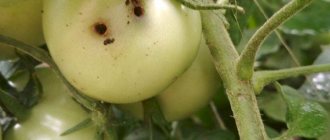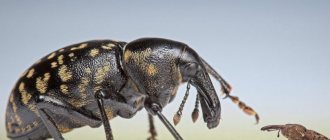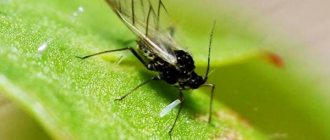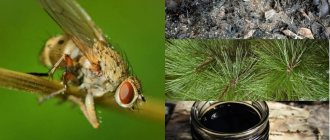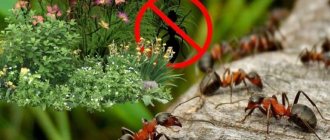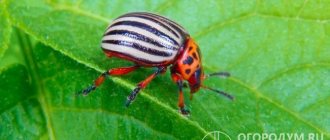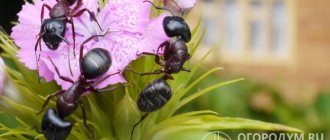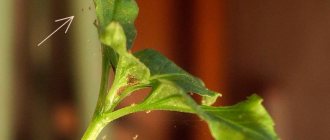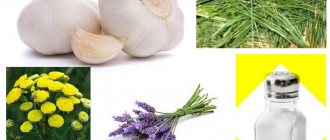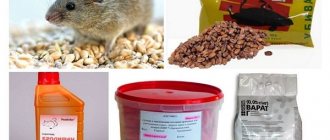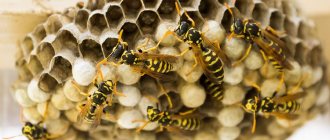Why are aphids dangerous for chrysanthemums?
Aphids are one of the most dangerous pests. There are several reasons for this:
- It sucks all the liquid out of the plant. As a result, the cells die, and the attacked part of the chrysanthemum withers.
- Honeydew, which is produced by aphids, dries, forming a film on the surface of the stems or leaves. Dew interferes with photosynthesis, but promotes the growth of sooty fungal infections.
- Insects are carriers of fungi and viruses that are dangerous to chrysanthemums, and in some cases are not even treatable.
REFERENCE! Aphids are especially dangerous for young chrysanthemums. It can destroy the plant in a couple of days.
What does it look like?
Aphids are miniature in size and quite difficult to see. The average length of the body is no more than 2-3 mm, but there are individuals with a body up to 7 mm. Other facts about the appearance of the insect.
- The body is ovoid (resembles a drop), easily pressed when pressed;
- The pest has 2 pairs of transparent wings, the hind wings are always shorter than the front ones;
- There are aphids without wings. Such individuals move only on the ground; they are usually carried by ants;
- On the head there are black eyes, 2 antennae, a proboscis;
- The color can be varied (black, green, red individuals). The color depends on the specific species.
In total, there are more than 4,000 species of aphids, each of which is characterized by external differences. Europe is a permanent habitat for 1000 species of pests. Different individuals settle on different crops.
- Garden trees, chrysanthemums, roses - green aphids ;
- Cornflowers, legumes – black aphids ;
- Cucumbers, melons, some tomatoes, potatoes - melon or potato ;
- Apple, pea, and tobacco aphids are also common .
If aphids are on indoor plants, how to deal with them:
Signs of aphids
Home and garden chrysanthemums are most often attacked by white and black aphids. It only takes one individual to become infected. Pests quickly adapt to any conditions and multiply rapidly. The female lays about 80 larvae at a time. With their proboscis, aphids pierce buds, leaves, flowers and suck out liquid.
If the leaves dry out and curl, black spots appear on them, and the buds dry out before they have time to bloom, look carefully at the plant. Typically, aphids choose the lower part of the leaves. It is easy to notice with the naked eye by turning the sheet over. You will see a cluster of insects in a dense colony, sticky secretions, excrement, skins of dead insects, and the surface itself will be covered in yellow spots from bites.
IMPORTANT! Aphids are carriers of fungal and viral infections, which ultimately lead to the death of the plant. Inspect the flower as often as possible so that at the first sign of a pest attack, take all necessary measures.
The difference between fighting aphids in the house and on the street is that at home you can get rid of them forever.
What causes aphids
Since the female aphid lays larvae in the ground, it is better not to use outdoor soil for planting indoor chrysanthemums. Where else do aphids come from: they can also get into the house from the street on shoes, clothes, in the fur of pets or through an open window. Collecting bouquets of meadow flowers or herbs also poses a risk of contamination of domestic flowers. Aphids will move to new plants from already infected neighbors.
If aphids attack a garden plot, then, as a rule, they come from neighboring infected ones. Small insects are easily carried by the wind. Some types of aphids have wings, so they may appear suddenly. For active reproduction, only one individual is enough. Honeydew, produced by aphids, is made of sugar, which attracts ants. They are also carriers of these pests, often protect aphids from others, and in cold weather they even provide shelter in an anthill.
REFERENCE! The connection between ants and aphids developed at the moment of the origin of life as a whole. Geologists have discovered many amber fossils in which aphids are frozen next to ants.
If the garden plot is located near a forest or field, then the appearance of aphids is inevitable, since the parasites’ favorite plants are clover, cornflowers, hazel, legumes, etc.
Preventive measures
Chrysanthemum is a plant with fairly strong immunity. It is not difficult to protect it from aphids if you follow simple prevention rules.
- New plants should be quarantined for two weeks (kept separately from other indoor plants in order to determine the presence of parasites and promptly begin treatment).
- Water the flowers in a timely manner, apply fertilizing (a weakened flower, experiencing a deficiency of nutrients, becomes more vulnerable; additional nutrition would make the plant stronger and more resilient).
- Periodically inspect the flowerpot to exclude the possibility of aphids.
- When replanting, use only high-quality tested soil and new pots.
Indoor chrysanthemums love a lot of light (therefore they should be placed on windows located in the southern part of the house), but do not tolerate heat or direct sunlight.
Immediately after purchasing from the store, the flowers should be inspected and all dry and damaged leaves and twigs should be removed.
When growing chrysanthemums at home, they should not be allowed to dry out. Timely watering and attention are important conditions for growing healthy plants.
Prevention methods
To prevent the appearance of midges, you must adhere to the following recommendations:
- Don't water the plants too heavily. This is especially true during the cold period of the year, when moisture slowly evaporates from the soil.
Disinfection of the premises helps in the fight against midges - Place expanded clay, river pebbles, charcoal and river sand at the bottom of the pot for planting indoor flowers to ensure drainage.
- If you bought a new flowerpot at the store, transplant it into another pot. When doing this, be sure to clean the roots of the plant. Also use a ready-made substrate that contains the optimal ratio of mineral endorsements.
- The soil for planting indoor flowers must be steamed in a water bath for several minutes.
- Place mosquito nets on the windows, especially on hot days. This will protect the flowerpots from pests that can fly in from the street.
Adhesive tape in flowerpots - The pot for planting house plants must be doused with boiling water.
- It is recommended to cover the surface of the soil of indoor flowers with small pebbles, marble or granite chips. This will prevent pests from multiplying because they will not be able to lay eggs.
- Periodically loosen the soil to ensure uniform evaporation of moisture.
- Inspect the flowerpot regularly, remove dried flowers, leaves, and stems. If they fall to the surface of the ground, be sure to clean the soil to prevent rotting.
- To feed plants, use only ready-made mineral fertilizers. The use of humus, infusion from onion peels or egg shells is strictly prohibited.
It will be very easy to get rid of midges if you follow these recommendations and use one of the above remedies.
Causes and diagnosis of appearance
When small black, green or white insects appear on a chrysanthemum, the owner should sound the alarm.
Aphids penetrate the closed ecosystem of a room in the following ways:
- with fresh flowers brought from the street;
- with contaminated soil;
- through the open window - with a winged female who had laid larvae in the pots of indoor plants.
After reproduction, numerous insects spread throughout the flower, mainly affecting the back of the leaves, young shoots and buds.
The presence of aphids is recognized by the following signs:
- curling or sticking of foliage;
- drying of unopened buds, cessation of flowering and general lethargy of the chrysanthemum;
- irregular shape and ugly outlines of flowers;
- accumulation of sticky sugary liquid on the plant.
In addition to signs of pest activity, the insects themselves and the remains of larval cocoons adhered to the leaves and buds of the flower are clearly visible.
Why do brown spots appear on leaves?
Light brown spots indicate a disease such as gray rot. The main reason is lack of air, which occurs if the bushes are located too close to each other. To prevent the disease, bushes are sprayed with copper-based preparations. It is also important to choose the right place for planting.
Black spots on chrysanthemum leaves are a sign of septoria. The causative agent of this disease lives in last year's foliage. For prevention you should:
- Do not plant plants too densely;
- Regularly thin out bushes;
- Remove diseased leaves;
- Avoid overwatering.
Means and methods of control
The health and existence of the plant depends on the attentiveness of the owner and the timeliness of the measures taken. Aphids can destroy a chrysanthemum in a few days. Pests drink the vital juices of the crop. An additional danger is associated with the transmission of infectious diseases by insects. Sugary deposits associated with aphid waste cause the appearance of black fungal formations and attract other pests.
In a confined space, the grower is limited in the use of chemicals. Products with increased toxicity are dangerous for people and pets. But, unlike garden plants, pests on indoor crops can be completely destroyed. The main thing is to choose the right treatment method and choose an effective remedy.
Next - more details about how to get rid of aphids on chrysanthemums at home.
Chemicals (Fitoverm, Inta-vir)
The most effective way to combat is the use of chemicals. It is recommended to wash the plant first under running water. Plants are treated with pesticides - by spraying or adding to the soil. The procedure is carried out in several stages:
- at the first sign of insects;
- secondary treatment after the expiration of the drug to destroy newly hatched or remaining pests.
The treated plant is covered with film for several hours.
To eliminate the risk of chemical poisoning, adhere to the following recommendations:
- work is carried out wearing gloves and respirators;
- upon completion of spraying, thoroughly wash your hands, face, and hair;
- protective equipment and auxiliary devices used during processing are disposed of.
More details about the best way to treat chrysanthemums against aphids at home:
- Fitoverm is a biological preparation with enteric contact action. The product is safe for humans and pets. Destroys, in addition to aphids, all types of mites, snails and other garden pests. Mode of action – paralyzes the nervous system, penetrating the insect’s body through the outer cover and with the sap of the plant, leading to death. In houseplant pests, the reaction occurs after six hours. The protection period is up to three weeks. One ampoule of five milliliters is diluted in five liters of water;
- Inta-vir is a synthetic agent that quickly infects insects. After exposure to the drug, pests experience spasms and convulsions, leading to death. One tablet is diluted in a liter of water. The plant is sprayed with a spray bottle, evenly spraying the composition onto all leaves and stems of the flower. The solution is prepared as needed. The drug should not be stored in diluted form due to its high toxicity. You should not perform more than three treatments - the pests develop immunity and the product loses its effectiveness;
- Actellik is a chemical composition that disrupts the functioning of the digestive and nervous systems of pests. It acts by penetrating the insect’s body with the juice of the treated plant. A milliliter of concentrate is diluted in a liter of water. The flower is sprayed, capturing the back side of the leaves. Relatively safe for humans, but can cause headaches and nausea. The room with treated plants is thoroughly ventilated;
- Neoron is a contact chemical preparation. Validity period is from ten to forty days. A two-milliliter ampoule is diluted in two liters of water. Repeated treatment is not required to get rid of insects; a single spray is sufficient.
Window cleaning liquid with ammonia is safe for humans and pets, but harmful to aphids. Two sprayings, carried out at intervals of a week, are enough to destroy pests.
Mechanical methods of struggle
In the absence of chemicals and a slight degree of infestation, mechanical methods of insect control will help:
- manual cleaning of the plant - aphids are collected by hand. Work is performed with gloves. The collected insects are destroyed;
- blowing with compressed air - the plant is taken outside, the aphids are blown away with a household hairdryer.
Mechanical methods are recommended to be used as additional safety measures or at the initial stage of infection. If insects spread massively, the plant will need to be treated with chemicals or folk remedies.
Folk remedies
If there are animals or small children in the house, the use of concentrated chemicals is unsafe. You can fight pests using folk remedies that do not contain toxic components:
- soap composition - twenty grams of tar soap are dissolved in one hundred and fifty milliliters of water. The resulting product is used to treat the soil around the flower and the entire chrysanthemum. Frequency of treatment – once a week, until the aphids are completely exterminated;
- ammonia - a milliliter of the substance is diluted in one hundred grams of water. The soil is covered with a film to prevent the composition from getting into the ground. The flower is sprayed from a spray bottle;
- garlic - one head is crushed, placed in a glass of water. The product is infused for about forty minutes. The volume of the finished concentrate is brought to a liter and filtered. Process every three hours until the desired result is achieved;
- tobacco decoction - a glass of crushed tobacco is poured with a liter of heated water. Infusion time is two days. The tincture is brought to a boil, cooled to room temperature, and filtered. The soil in the pot is protected with film. The crown of the flower is completely sprayed. The procedure is repeated after ten days;
- citrus peels - a glass of crushed orange or lemon peel is poured with a liter of boiling water. The product is infused for seventy-two hours and filtered. The plant is treated twice a day; in case of severe infection, the number of treatments can be increased to five per day;
- onion peels - one hundred grams of peelings are poured with one and a half liters of water. The liquid is boiled for ten minutes and drained by filtration. Chrysanthemum is processed twice a day until results are achieved.
To increase efficiency, it is recommended to alternate folk remedies with the selection of the most effective formulations. If insects are not destroyed by natural solutions, you will have to resort to chemicals.
Harm from thrips
These pests pierce the cells of leaves , inflorescences, and flower petals and suck out the juice from them. In places where thrips have already visited, voids appear in the leaves, causing their surface to become shiny and silvery. Over time, sooty or other bugs penetrate into the empty spaces of the leaves. Leaves infected with thrips no longer take part in photosynthesis and dry out after a short time.
Certain varieties of thrips live on flowers and buds, feeding on the juice of the petals of open flowers. Why do the buds get an ugly appearance, fall off without ever opening, and even if they do open, this flower will no longer be completely decorative. In addition, insects are carriers of a number of viral diseases, for example, the curl virus or ring spot virus.
In the case when the attack of thrips is directed at already opened flowers of the bushes, the petals of the bud become covered with scratches, brown-yellow spots, dry out quickly, the inflorescences wither before the due time, and the flowers quickly fall off. Flowers with white buds suffer most from these pests . Almost all garden plants suffer from thrips.
Of the indoor flowers, the following plants are most susceptible to infection by these pests:
- amaryllis;
- anthurium;
- ficus benjamina;
- begonia;
- rubber ficus;
- orchids;
- variegated ficus;
- collision;
- blue passionflower;
- dieffenbachia;
- bell;
- fuchsia;
- chrysanthemum;
- palm trees;
- cineraria;
- monstera;
- cyclamen.
When thrips attack leaves, they can very easily be confused with spider mites , since in both cases the leaves get a silvery color.
But, unlike mites, thrips do not create webs between foliage. A clear sign of the presence of thrips is the presence of fallen pollen from the pistils on the petals of flowers or on the foliage of the bush. However, pollen also falls off during hot weather, gusty winds, during transportation, or when someone simply passed nearby and touched a bush. Looking carefully at the buds and petals of flowers, you can see yellow inclusions or scratches; their presence significantly reduces the decorative effect.
In order to make sure that there are pests on the flowers, you need to pick a couple of buds and shake them over clean paper.
It is quite difficult to accurately identify which particular type of thrips is in your gardens and apartments, due to their small size and rapid variability of species. The most common pests are:
- American Floral;
- western floral;
- dracaena;
- rose;
- bulbous;
- tobacco and a number of other types.
Traditional methods
What people can come up with to get rid of aphids. In fact, there are a lot of traditional methods of combating these insects. And they are all effective in their own way. However, it is worth considering the fact that any folk remedy destroys not only pests, but also beneficial insects. And in order for the effectiveness of the products to be higher, it is recommended to treat plants in the evening, when the guard ants go to spend the night in the anthill - this will eliminate the possibility of them saving aphids. Let's look at some of the simplest and most effective ways to combat aphids.
Water and liquid soap
In a spray bottle, dilute 2 cups of water and 2 tsp. liquid soap (you can use dishwashing detergent). Additionally, you can add a glass of vegetable oil, although this component is not mandatory.
Treat shrubs affected by aphids with this solution in the evening, carefully spraying in areas where pests are abundant. Repeat the procedure for several days in a row until the aphids disappear.
Garlic infusion
For infusion, take:
- 3-5 cloves of garlic (chopped with a press);
- 0.5 l of water;
- 2 tsp vegetable oil;
- 1 tsp detergent (liquid soap).
Crushed garlic is infused for at least 24 hours in water. Then add detergent and oil, mix, pour into a container that can be tightly closed with a lid. Before use, the solution (in the amount of 2 tablespoons) is poured into a spray bottle and the plants affected by aphids are treated.
Plant infusions
An infusion for treating trees, bushes and flowers against aphids can be made based on tobacco leaves, tansy, sophora, onion, celandine, marigold or wormwood. Any of these plants is crushed and poured into a bucket with warm water. Cover the mixture tightly and leave for 24-48 hours. Next, the solution is taken into a spray bottle and the plants are treated against aphids.
Decoction or infusion of celandine
Celandine helps people with many diseases. But this plant is also very effective in the fight against aphids. Celandine is collected during its flowering period (the entire bush is used). When crushed, you should get 300-400 g of fresh herb (or 100 g of dry). Pour celandine into 1 liter of water, boil for 30 minutes or leave for 1-1.5 days, tightly closing the container. When the infusion (decoction) is ready, treat the plants against aphids by spraying the solution from a spray bottle.
Wood ash
Our grandparents used this wood burning product to fight aphids. Prepare a solution from wood ash as follows: take 2 cups of ash per bucket of water (10 l). Leave the solution for at least a day. Dilute 50 g of laundry soap into the infusion, after which the plant is treated by spraying.
Other folk methods
It is known that the appearance of ants on trees and bushes directly depends on the appearance of aphids on these plants. Therefore, it is important to prevent ants from crawling on trees. To do this, you can wrap the tree trunk with adhesive material, sticky side out. You can treat the lower part of the trunk with an adhesive substance, but you should first make sure that it will not harm the tree. These simple steps will repel ants from trees, which means they will not be able to spread aphids along the trunks and leaves.
Dandelion officinalis in the amount of 300 g if the root is used, or 400 g if fresh leaves are used, finely chopped. Then add the herb to 10 liters of warm water (no more than 400C) and leave to infuse for a couple of hours. Before use, filter the infusion, pour it into a spray bottle and spray the affected plants.
Most pests can be washed off with a strong stream of water. Individuals that were washed to the ground no longer return to the plant. The honeydew is also washed off this way. All this helps reduce the aphid population. It is important to carry out this procedure in the morning: during the day the plants will dry quickly, which will prevent the development of fungal diseases.
Traditional methods of killing aphids on trees and bushes are good because they are absolutely safe, since natural products are used for their preparation. Despite this, the effectiveness of such means is good, although the result does not come instantly. Thus, treatment with each of these agents should be carried out 2-3 times, with an interval of 5-7 days. If this is not done, the pest will return to the plants, and subsequent treatment with the same product will be ineffective, since the aphids adapt to its composition.
Types of thrips
California thrips
The adult size is approximately 2 mm, the color can vary from bright yellow to gray-yellow. This type of insect prefers to be on flowers and buds, but the pest is also likely to reproduce on leaves. These thrips are most dangerous because they are considered carriers of the tomato virus , which gives tomato petals a bronze color.
California thrips is a fairly large polyphage. This bug can be found on cucumbers, peppers, tomatoes, onions, apricots, grapes, strawberries and some other vegetable and fruit crops, as well as on various floral and decorative flowers: roses, bells, gerberas, tulips, chrysanthemums, daisies, cyclamen, cineraria , Saintpauliah.
Adult species and larvae of this pest feed on the cell sap of flowers. This first creates the formation of yellow veins on the berries, leaves or buds, streaking; Over time, plant cells in these areas of infection die. Damage to flower buds in vegetable and fruit plants creates deformation of flowers and berries.
For example, significant curling of the inflorescences and curling of ripening tomato fruits is the first sign that this insect is on the bush. On chrysanthemums in the presence of California thrips, infected buds do not open and die.
Tobacco thrips
This pest reaches a size of up to 1.4 mm and has a bright brown or pure brown color. The larvae may be light brown, yellow or white.
The insect infects more than 450 varieties of cultivated plants. This number includes both ornamental and vegetable plants. Most of all, this type of thrips causes harm to garlic, eggplants, onions, tomatoes, cucumbers, melons - melons, watermelons, pumpkins, and less often parsley, cabbage, radishes, turnips.
American thrips
The bug is brown or dark brown in color, ranging in size from 1.4 mm (male) to 1.9 mm (female). This type of insect prefers to be most often on the leaves, where the females leave larvae in the tissues.
This variety of thrips was identified in the 80s. last century in Holland at the most popular flower exhibition, where plants from all over the world are displayed. The insect was first discovered on chrysanthemums. Today, this bug is transported around the world on cut flowers, shoots, and potted indoor plants.
Initially, thrips activity is noticeable by the formation of yellow spots . The presence of already one dozen thrips on one bush is already enough for the flower to wilt. 40-50 bugs can lead to drying and falling of leaves, which occurs from the lower tier. And although this species does not directly lead to the death of the bush, pests significantly reduce the decorativeness of plants. In search of food, insects move to flowers and berries or to nearby plants, and in this place they begin their life activities.
Since the population of this type of thrips spreads quite quickly, there is a high probability of its presence both on all ornamental and flower bushes, and on other vegetable plants that are grown in greenhouses and greenhouses.
Black thrips
Adults can reach a length of approximately 1.2-1.6 mm , are dark brown or almost black in color with a dark brown belly and yellow wings. The larvae are yellow or white in color; unlike adult insects, they are slightly shorter and lack wings.
The larvae and adults of this pest species are usually found on the underside of the leaves. The degree of damage to flowers is almost the same as that of tobacco species.
On closed land (in greenhouses, greenhouses), black thrips are found everywhere and can reproduce year-round. Both adults and their larvae cause harm; they cause the greatest damage to cucumbers, tomatoes, and other vegetable and fruit plants, as well as decorative and potted flowers, especially chrysanthemums. Black thrips tolerate frost well in the top layer of soil in compost pits or under vegetation debris.
Dracaena thrips
Adult beetles can be up to 1.5 mm in size , females are brownish-yellow in color, males are slightly smaller and lighter in color. The larvae are white in color.
This type of insect is also a large polyphagous plant and is found on the foliage of quite a large number of varieties of decorative flowers: monsteras, orchids, tradescantia, aralia, hibiscus, chrysanthemums, anthuriums, dracaenas, ficus, palms and so on. In its natural environment, dracaena thrips most often lives in subtropical and tropical climates. In the northern regions, it is more common on bushes located in greenhouses and greenhouses.
In industrial greenhouse conditions, thrips are almost impossible to completely destroy . In the best case scenario, their quantity is maintained at a level that would not affect the commercial properties of the products. This is explained by the fact that pests have fairly good adaptation to poisons and chemicals. This is especially true for insects that feed on flowers.
Description of the signs of chrysanthemum diseases - prevention, how to treat and fight
The most harmful include:
Powdery mildew
A powdery coating appears on all organs of diseased flowers.
Prevention and treatment
We treat chrysanthemums with Fitosporin-M, Alirin-B. In case of extensive damage to the bushes, we treat them with Topaz, Strobe, Skor, Chistotsvet, Thiovit Jet. As preventive measures, we use the selection of flower varieties that are most resistant to this disease, regular application of phosphorus-potassium fertilizers to the soil, root watering of bushes, periodic removal of lower leaves and various plant debris.
Soft rot
Some parts of chrysanthemums fade. At the same time, the stems of the plant turn black and become soft. They easily break along the shoot. The vessels inside the stems acquire a brownish tint. This disease most often affects bushes located in greenhouses or greenhouses in the summer.
Control measures
Infected flower specimens are immediately destroyed. We water the remaining bushes to the very roots with Fitosporin-M or Plirin-B.
Bacterial cancer
Tumors of varying sizes appear on stems and foliage.
Fighting methods
We burn specimens infected with the disease.
Bacteriosis
The causative agent of this plant disease is a soil bacterium that causes the formation of growths at the root neck of the bush that resemble cauliflower in shape. Chrysanthemum stems become fleshy and ugly.
How to fight
The resulting tumors are removed.
Stem rot
Affected chrysanthemums wilt, and the lower part of the stems becomes brownish-black. Then the rot spreads to the lower leaves.
Prevention and control
We burn infected specimens. We treat the remaining plants with Baktofit, Fongilan or Trichodermin. To prevent disease, we provide the plantings with good drainage so that the water in the place where they grow does not stagnate.
Fomoz
The leaves become faded yellow and then acquire a brownish tint.
Ways to fight
We burn infected specimens.
Verticillium wilt
Chrysanthemum leaves wither and dry out. At the same time, they do not fall off, but remain on the shoot.
Prevention and control methods
We burn infected flower specimens. In order to prevent the disease, we treat the bushes with Alirin-B and Gamair.
White rot
Chrysanthemums wither and brownish spots appear on their stems. Inside the shoots you can find white mycelium resembling felt. Black sclerotia are visible in it.
Control measures
We burn the specimens infected with the disease, and treat the remaining ones with Rovral.
Gray rot
This disease affects flowers in the fall, in humid and warm weather. Their petals become covered with brown spots, and the buds begin to rot from the base. All plant tissues soften and acquire a watery structure. In humid weather, a gray coating of mold appears on them.
How to fight
We cut out the dying parts of the chrysanthemums. We treat the bushes with such preparations as Skor, Fundazol, Ronilan, Rovral, Chistotsvet.
Ascochyta blight
Dark brown or almost black spots quickly spread on all parts of the flower. Young stems wither and the chrysanthemum gradually dies.
Fighting methods
We burn infected plant specimens.
Septoria spot
Grayish round spots appear on the foliage of chrysanthemums.
Ways to fight
We burn infected specimens. To prevent the occurrence of the disease, we treat the plants with copper sulfate, Ditan Ultra, and copper oxychloride.
White rust
Convex spots of a light shade form on the upper part of the leaf blade of the plant. Waxy sporangia appear at the bottom of the leaf in the shape of a circle. Gradually they acquire a cinnamon tint.
Means of struggle
We destroy leaves infected with the disease. We treat flowers alternately with various preparations, since this fungal disease adapts to various chemicals. We spray chrysanthemums with copper oxychloride, Abiga-Pik.
Ramulariasis
Yellowish or brownish spots appear on the leaf blades.
Control measures
We burn infected specimens. We treat the remaining bushes with Rovral or Saprol.
